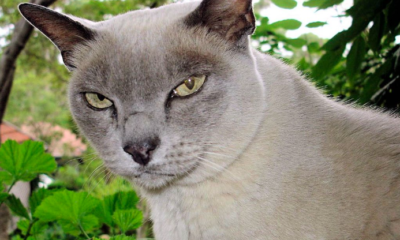Cats
The 10 Most Intelligent Cat Breeds: A Guide to Smart Feline Companions

The 10 Most Intelligent Cat Breeds: A Guide to Smart Feline Companions
Introduction: Deciphering Feline Intelligence
Cats are renowned for their independence, agility, and mysterious demeanor. But did you know that behind those mesmerizing eyes lie varying degrees of intelligence?
From problem-solving skills to social adaptability, certain cat breeds exhibit remarkable cognitive abilities that set them apart from the rest.
In this comprehensive guide, we delve into the 10 Most Intelligent Cat Breeds that captivate us with their cleverness and charm.
1. Abyssinian Cat
Origin: Ancient Egypt
The claim that Abyssinian cats originated from Ancient Egypt is a common misconception. Despite the lore associating them with Egyptian pharaohs, the Abyssinian cat breed is not believed to have originated from Egypt.
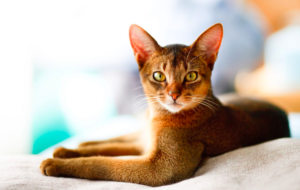
Instead, research suggests that Abyssinians likely developed along the Indian Ocean’s coastal regions and parts of Southeast Asia.
The name “Abyssinian” is somewhat misleading as it was given to these cats based on their resemblance to ancient Egyptian cats depicted in artwork, not because of their actual origin in Egypt. The breed’s history is more closely linked to regions along the Indian Ocean and Southeast Asia, rather than Ancient Egypt
Characteristics: Curious, Energetic, Affectionate
The Abyssinian cat breed is characterized by being curious, energetic, and affectionate. These cats are known for their intelligence, agility, and outgoing nature. They are excellent climbers, hunters, and jumpers, thriving in environments where they can explore and play mischievously with their humans and other cats.
Abyssinians have a playful and active temperament, enjoying interactive playtime and climbing to high places like cat trees or shelves. Despite not being big cuddlers or lap cats, they love spending time with their human family and can suffer from depression without regular attention and affection.
Their curious and playful nature, combined with their need for mental stimulation and physical activity, make them a delightful addition to households that can provide them with the engagement they crave
Intelligence Traits: Quick learners, Agile problem solvers
The Abyssinian cat breed is known for its intelligence traits, being quick learners and agile problem solvers. These cats are highly intelligent and curious, which contributes to their ability to learn quickly and adapt to new situations.
Their inquisitive nature and sharp minds make them adept at solving problems and figuring out puzzles, showcasing their cognitive abilities and mental agility.
This intelligence trait, combined with their energetic and playful demeanor, makes Abyssinians engaging and interactive companions for those who appreciate their cleverness and lively personality
Notable Feats: Easily trainable, Enjoys interactive play
The Abyssinian cat breed is notable for being easily trainable and enjoying interactive play. These cats are highly intelligent and curious, making them quick learners and agile problem solvers.
Their inquisitive nature and sharp minds allow them to pick up tricks and new lessons easily, making them a delight to train and engage with. Abyssinians are known for their love of interactive play, where they can showcase their agility, athleticism, and playful demeanor.
They are not typical lap cats but are in constant motion, exploring their surroundings, playing, and seeking interaction with their human companions. Their social nature and love for play make them excellent companions for those who can provide them with the mental stimulation and engagement they crave
2. Siamese Cat
Origin: Thailand (formerly Siam)
The Siamese cat breed originates from Thailand, formerly known as Siam. This breed’s history dates back to ancient Siam, now Thailand, where the Siamese cats were exclusive to the royal family and the higher class.
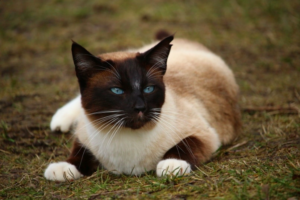
They were highly valued and considered a great honor to receive as a gift, with the theft of a Siamese cat being punishable by death. The cats were noted for their distinctive features like crossed eyes and kinked tails, which were selectively bred out over time.
Siamese cats were transported to Europe in the late 1800s, with King Chulalongkorn of Siam sending some as emissaries to Europe. The breed quickly gained popularity in Europe and North America, becoming one of the most beloved cat breeds globally
Characteristics: Vocal, Social, Playful
The Abyssinian cat breed is characterized by being vocal, social, and playful. These cats are known for their expressive and soft voices, using chirps and other sounds to communicate with their human companions.
They are social cats that enjoy interacting with people and other animals, making them great additions to active families. Abyssinians thrive on companionship and can become bored if left alone for extended periods, so having another cat or pet around can help keep them entertained.
Their playful nature shines through in their love for interactive games, climbing, and exploring their environment. Abyssinians are intelligent and agile cats that enjoy mental stimulation and physical activity, making them engaging and entertaining companions for those who appreciate their vocal, social, and playful characteristics
Intelligence Traits: Excellent communicators, Crave human interaction
The Abyssinian cat breed is known for its intelligence traits, being excellent communicators and craving human interaction. These cats are highly intelligent and curious, which allows them to effectively communicate with their human companions through various sounds like chirps and soft meows.
They are social cats that enjoy interacting with people and other animals, seeking attention and companionship. Abyssinians are not typically lap cats but prefer to be in the same room as their family members, engaging in play, exploration, and seeking interaction.
Their intelligence and social nature make them excellent communicators who can express their needs and desires effectively, making them delightful companions for those who appreciate their interactive and engaging personalities
Notable Feats: Masters of learning tricks, Form strong bonds with owners
The Abyssinian cat breed is known for being masters of learning tricks and forming strong bonds with their owners. These cats are highly intelligent and can be successfully clicker-trained to perform tricks, showcasing their ability to learn and adapt to training.
They are also capable of walking on a leash and even participating in agility courses, demonstrating their intelligence and agility. Abyssinians form strong bonds with their owners, displaying a dog-like attachment and preferring to be actively involved in family life.
They are extroverted and love interacting with people, seeking attention and companionship from their human family members. This breed’s loyalty and affectionate nature make them excellent companions for those who appreciate their intelligence, playfulness, and strong bond-forming capabilities
3. Maine Coon
Origin: United States (Maine)
The Maine Coon cat breed originates from the United States, specifically the state of Maine. While there are various theories surrounding the exact origin of the Maine Coon, it is widely accepted that this breed developed in the North Eastern parts of America around the mid-19th century.

The Maine Coon is considered one of the oldest natural breeds in North America and is even recognized as the official state cat of Maine. Despite some folklore suggesting hybrid origins involving raccoons or bobcats, the most credible theory points to the breed evolving from cats brought to New England by early settlers, including European longhairs like the Angora, and local short-haired cats.
The Maine Coon’s distinctive features, large size, and friendly, dog-like characteristics have made it a beloved and widely recognized breed globally
Characteristics: Gentle giants, Sociable, Adaptable
The Maine Coon cat breed is characterized as gentle giants, sociable, and adaptable. These cats are known for their large size, friendly demeanor, and ability to adapt well to various environments. Maine Coons are often referred to as gentle giants due to their impressive size and affectionate nature.
They are sociable cats that enjoy the company of people, making them great companions for families and other pets. Additionally, Maine Coons are highly adaptable, thriving in different living situations and climates.
Their friendly and adaptable nature, combined with their striking appearance and playful personalities, have made them one of the most popular and beloved cat breeds globally.
Intelligence Traits: Highly adaptable, Skilled hunters
Based on the provided sources, Maine Coon cats are known for their intelligence and unique traits. They are highly adaptable creatures that can quickly learn and adapt to new situations. Maine Coons are intelligent and trainable, much like dogs, responding well to positive reinforcement training methods.
Their high prey drive and problem-solving abilities make them skilled hunters, capable of figuring out how to open doors and cabinets. Additionally, Maine Coons have a remarkable memory, allowing them to remember their owners even after extended periods of absence.
These cats are social and affectionate, forming strong bonds with their human companions and enjoying being involved in household activities. Their playful nature, curiosity, and love for water set them apart from many other cat breeds, making them engaging and interactive pets that create deep relationships with their owners
Notable Feats: Problem-solving prowess, Affectionate nature
Based on the provided sources, Maine Coon cats are known for their notable feats, including problem-solving prowess and affectionate nature. These cats exhibit exceptional problem-solving skills, which is evident in their ability to figure out puzzles, open doors, and navigate various challenges.
Maine Coons are intelligent and resourceful, using their cognitive abilities to overcome obstacles and find solutions to different situations. Additionally, they are renowned for their affectionate nature, forming strong bonds with their human companions.
Maine Coons are loyal, loving, and enjoy being around people, often displaying dog-like loyalty and affection towards their owners. Their combination of problem-solving abilities and affectionate demeanor makes them delightful companions for those who appreciate their intelligence and loving nature
4. Sphynx
Origin: Canada
The Sphynx cat breed originates from Canada, specifically from Toronto, where the first naked cat was born in 1966. This unique breed, originally named the Canadian Hairless, emerged from a litter of domestic shorthair kittens that included a hairless kitten due to a natural genetic mutation.

Over time, breeders selectively bred these hairless cats with normal-coated cats, leading to the development of the Sphynx breed as we know it today. The Sphynx cats are medium-sized, weighing between 6 to 12 pounds, with a lifespan of 8 to 14 years. They are characterized by their hairless, wrinkled skin, large ears, and sleek, muscular bodies.
Despite their lack of fur, Sphynx cats are not hypoallergenic, as they still produce allergy-causing dander. These cats are energetic, loyal, and often described as dog-like in their behavior, enjoying play, exploration, and affectionate interactions with their human companions.
The Sphynx breed has gained popularity over the years and is recognized for its unique appearance, friendly personality, and playful nature, making them delightful and engaging pets for those who appreciate their distinct characteristics
Characteristics: Hairless, Curious, Energetic
Based on the provided sources, the Sphynx cat breed is characterized by being hairless, curious, and energetic. Sphynx cats are known for their unique appearance, lacking fur but often having a “peach-fuzz” coating of hair that is very short.
They have wrinkled skin, large ears, and a sleek, muscular body. Despite their regal look, Sphynx cats are playful and goofy companions who exhibit dog-like behaviors at times. These cats enjoy basking in sunspots for warmth, making them excellent cuddle buddies.
In terms of personality traits, Sphynx cats are described as affectionate, friendly, energetic, and loving. They are sociable felines that seek companionship and are known to be loyal members of the family.
Sphynx cats are very energetic creatures that love to play and explore, but they also enjoy cuddling and seeking out affectionate interactions with their human family members. Their high energy levels and inquisitive nature make them engaging pets that require attention and regular interaction to thrive happily in a household
Intelligence Traits: Inquisitive, Affectionate
The Sphynx cat breed is known for its unique traits, including being hairless, curious, and energetic. Sphynx cats have a distinctive appearance with a nearly hairless body, wrinkled skin, and large ears and eyes. Despite their lack of fur, they may have a peach fuzz-like coating.
These cats are characterized by their high energy levels, intelligence, and playful nature. Sphynx cats are curious creatures that love to explore and engage in interactive play. They are highly energetic and require mental stimulation to keep them entertained.
Additionally, Sphynx cats are known for their affectionate nature, forming strong bonds with their human companions and seeking attention and companionship. Their combination of curiosity, energy, and affection makes them unique and engaging pets for those who appreciate their distinct characteristics
Notable Feats: Loves interactive toys, Thrives on attention
Based on the provided sources, the Sphynx cat breed is known for its unique traits, including being hairless, curious, and energetic. Sphynx cats have a distinctive appearance with a nearly hairless body, wrinkled skin, large ears and eyes. Despite their lack of fur, they may have a peach fuzz-like coating.
These cats are characterized by their high energy levels, intelligence, and playful nature. Sphynx cats are curious creatures that love to explore and engage in interactive play. They are highly energetic and require mental stimulation to keep them entertained.
Additionally, Sphynx cats are known for their affectionate nature, forming strong bonds with their human companions and seeking attention and companionship. Their combination of curiosity, energy, and affection makes them unique and engaging pets for those who appreciate their distinct characteristics
5. Bengal
Origin: United States (Breed developed from Asian Leopard Cat)
The Bengal cat breed originates from the United States and was developed from crossing an Asian Leopard Cat with a domestic cat. The breed was created to combine the wild appearance of the Asian Leopard Cat with the temperament and personality of a domesticated cat.
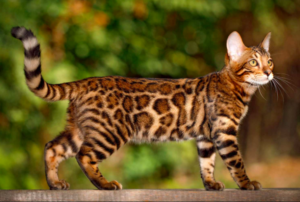
Bengals have a distinctive look with markings like spots, rosettes, arrowhead markings, or marbling, reflecting their wild ancestry. The breed officially received its name in 1974 and has become well-known for its unique appearance and playful nature.
While the Bengal cat retains some of the wild blood of its ancestors, modern Bengals are primarily bred from Bengal-to-Bengal bloodlines, with only an estimated 6% of wild blood. It is essential to obtain Bengal cats from reputable breeders who follow breeding standards to ensure the health and quality of the breed
Characteristics: Athletic, Playful, Curious
The Bengal cat breed is characterized by being athletic, playful, and curious. Bengals are known for their stunning appearance with eye-catching soft coats and wild, spotted markings. They are highly intelligent, active, and playful cats that exhibit a high level of energy and athleticism.
Bengals are often described as the rock stars of the feline world due to their striking looks and big personalities. These cats have a wild appearance but are sweet and loving companions that form strong bonds with their human family members.
Bengals are curious creatures, always exploring their surroundings and showing a keen interest in their environment. They are vocal cats, expressing themselves through various sounds and interactions with their owners. Additionally, Bengal cats are intelligent animals that quickly learn to manipulate their owners and engage in playful antics.
Their social nature makes them crave companionship and interaction, requiring attention and engagement to keep them happy and entertained. Overall, Bengal cats are active, playful, and inquisitive pets that bring energy and excitement to their households
Intelligence Traits: Highly active, Agile problem solvers
The Bengal cat breed is known for its high intelligence, agility, and problem-solving abilities. Bengals are intelligent creatures that can easily learn commands and tricks, making them interactive and trainable pets.
Their sharp instincts, inherited from their wild ancestry, enable them to be quick learners and adept problem solvers. Bengals thrive on mental stimulation and require constant engagement to keep their active minds engaged.
Additionally, their energetic nature and agility contribute to their ability to navigate challenges and find solutions effectively. This combination of intelligence, agility, and problem-solving skills makes Bengal cats stand out as highly active and agile problem solvers within the feline world
Notable Feats: Masters of agility, Enjoy learning new tricks
The Bengal cat breed is known for its agility and intelligence, making them masters of agility and quick learners when it comes to picking up new tricks. Bengals are highly active and athletic cats that enjoy engaging in physical activities, such as climbing, jumping, and playing.
Their agility allows them to move swiftly and gracefully, showcasing their natural athleticism. Additionally, Bengals are intelligent and curious cats that thrive on mental stimulation and interaction.
They enjoy learning new tricks and can be trained to perform various behaviors through positive reinforcement methods. Their combination of agility, intelligence, and eagerness to learn makes Bengals adept at mastering agility challenges and enjoying the process of acquiring new skills and tricks
6. Burmese Cat
Origin: Burma
The Burmese cat breed originates from Myanmar, which was previously known as Burma. The breed has a rich history dating back to the early 1930s when a walnut brown-colored female cat named Wong Mau was brought from Myanmar to the United States by Dr. Joseph Thompson.

Wong Mau was then bred with a Siamese seal point male to further develop the Burmese breed. In 1936, the Burmese cats were officially recognized by the Cat Fanciers’ Association (CFA). The breed has two main types, the American and the British Burmese, each with distinct physical characteristics and coat colors.
Burmese cats are known for their playful, athletic, affectionate, and intelligent nature. They are considered to be almost dog-like in their loyalty to their human family, making them excellent companions. The breed is generally healthy but can be prone to certain health issues like hypokalemia, glaucoma, and cranial deformities.
Burmese cats have short, fine coats that require minimal grooming and are known for their glossy appearance. Overall, the Burmese cat breed, originating from Myanmar, is cherished for its unique characteristics and loving temperament
Characteristics: Affectionate, Social, Vocal
The Burmese cat breed is characterized by being affectionate, social, and vocal. These cats are known for their loving and friendly nature, forming strong bonds with their human family members. They are highly social cats that enjoy being around people, including children and other pets.
Burmese cats are often described as almost dog-like in their loyalty and devotion to their owners. Additionally, they have a tendency to be vocal, using their sweet voices to communicate with their humans.
This breed thrives on human interaction and companionship, making them ideal for households where they can receive attention and engage in playful activities. Overall, the Burmese cat’s affectionate, social, and vocal characteristics contribute to their reputation as loving and interactive companions
Intelligence Traits: People-oriented, Eager learners
The Burmese cat breed is known for its intelligence, being people-oriented, and as eager learners. These cats are highly social and thrive on human interaction, forming strong bonds with their owners.
Burmese cats are known for their loyalty and devotion to their human family members, making them people-oriented pets that enjoy being in the company of their loved ones. Additionally, their intelligence and eagerness to learn make them quick learners, allowing them to pick up new tricks and behaviors easily.
Burmese cats are not only affectionate and playful but also display a high level of intelligence, making them excellent companions that enjoy engaging with their humans and learning new things
Notable Feats: Thrive in interactive environments, Form strong bonds with owners
The Burmese cat breed is known for thriving in interactive environments and forming strong bonds with their owners. These cats are loving, attentive, and family-oriented pets that enjoy being actively engaged with their human family members.
Burmese cats thrive in environments where they receive attention, playtime, and interaction, making them ideal companions for households that can provide them with the mental and physical stimulation they need.
Additionally, Burmese cats are known for forming strong bonds with their owners, displaying deep loyalty and affection towards their human companions.
Their loving and inquisitive nature makes them excellent pets for individuals or families looking for a devoted feline companion that enjoys interactive play and close relationships with their owners. Overall, the Burmese cat breed excels in interactive environments and is known for forming lasting and strong bonds with their human family members
7. Scottish Fold Cat
Origin: Scotland
The Scottish Fold cat breed originated in Scotland in the 1960s when a kitten named Susie was discovered with folded ears in a litter of non-folded cats. This unique trait was due to a spontaneous genetic mutation that led to the development of the Scottish Fold breed.
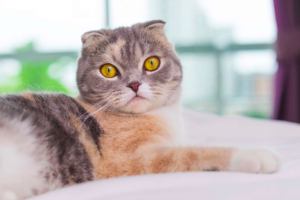
The folded ears of Scottish Folds are a result of an incompletely dominant gene that affects the cartilage in the ears, causing them to fold forward and downward, giving the cats a distinctive appearance. While Scottish Fold kittens are born with straight ears, the fold begins to develop when they are between 18 and 24 days old if they carry the gene responsible for the fold.
Responsible breeding practices involve not breeding Scottish Folds together due to ethical concerns about potential health issues in offspring. Instead, they are typically bred with American Shorthairs or British Shorthairs, resulting in not all kittens in a litter having folded ears, which contributes to the rarity of Scottish Folds
Characteristics: Folded ears, Sweet-natured, Gentle
The Scottish Fold cat breed is characterized by its distinctive folded ears, sweet-natured temperament, and gentle demeanor. These cats are known for their unique appearance, with their small ears that fold forward and downward, giving them an owl-like countenance.
The fold in their ears is a result of a genetic mutation that affects the cartilage, leading to this characteristic feature. Despite their folded ears, Scottish Folds use their ears to express themselves, swiveling them to listen and displaying various emotions.
In terms of personality, Scottish Folds are sweet-tempered and affectionate cats that enjoy human companionship. They are sociable and get along well with other pets and children, making them ideal for multi-pet households. These cats thrive on gentle handling and cuddle time, preferring a balance of play and quiet affection.
While Scottish Folds are known for their loving nature, it’s important to note that responsible breeding practices avoid breeding cats with two copies of the gene responsible for folded ears due to potential health issues like osteochondrodysplasia. Overall, the Scottish Fold breed is recognized for its folded ears, sweet-natured disposition, and gentle personality
Intelligence Traits: Observant, Adapt well to routines
The Scottish Fold cat breed is known for being observant and adaptable to routines. These cats are intelligent and quick to pick up on patterns and routines in their environment. Their observant nature allows them to notice changes and adapt well to established schedules, making them creatures of habit that thrive in predictable environments.
Scottish Folds are known for their ability to learn and remember routines, responding positively to consistency and structure in their daily lives. This intelligence trait, combined with their gentle and friendly demeanor, makes Scottish Folds excellent companions that can easily adjust to various lifestyles and routines, bringing joy and companionship to their human families
Notable Feats: Enjoy puzzle toys, Develop strong attachments to owners
Scottish Fold cats are known for their notable feats of enjoying puzzle toys and developing strong attachments to their owners. These cats exhibit intelligence and curiosity, making them fond of puzzle toys that challenge their minds and keep them engaged.
The Scottish Fold’s love for puzzle toys not only provides mental stimulation but also encourages physical activity, contributing to their overall well-being. Additionally, Scottish Folds are recognized for their ability to form strong attachments to their owners.
These cats are affectionate, loyal, and thrive on human companionship, often seeking out close interactions and forming deep bonds with their human family members. Their loving and devoted nature makes them excellent companions that enjoy spending time with their owners, showing affection, and seeking attention.
Overall, Scottish Fold cats’ enjoyment of puzzle toys and their strong attachments to their owners highlight their intelligent and affectionate nature, making them delightful pets for those seeking a loving and interactive feline companion
8. Tonkinese
Origin: United States (Breed developed from Siamese and Burmese)

The Tonkinese cat breed originated in the United States and is a hybrid of the Siamese and Burmese breeds. This unique feline combines the best qualities of both parent breeds, resulting in a cat that is smart, sweet, and sociable. The Tonkinese has a lean yet sturdy build with soft, muted colors and a charming personality.
They are known for their chirp-like voice and moderate level of vocalization compared to their Siamese relatives. The breed’s history dates back to the 1930s when Wong Mau, a cat imported from Burma by retired Navy doctor Joseph Thompson, was initially considered a poor-quality Siamese by U.S. breeders.
Wong Mau is now credited as the “mother” of both the Burmese and Tonkinese breeds due to genetic testing revealing her to be a Burmese-Siamese cross. The Tonkinese breed was firmly established in the 1960s by Jane Barletta, a Siamese breeder in New Jersey, who worked diligently to develop this “moderate” Siamese breed.
Thanks to Barletta’s efforts, the Tonkinese breed gained recognition and acceptance by major cat associations like the Cat Fanciers’ Association in 1979. Today, the Tonkinese is known for its friendly, sociable nature, making it an ideal pet for families seeking an affectionate and playful companion
Characteristics: Playful, Affectionate, Talkative
The Tonkinese cat breed is characterized by being playful, affectionate, and talkative. These cats are known for their lively and interactive nature, enjoying playtime and engaging with their human companions.
Their affectionate demeanor makes them loving pets that seek out attention and enjoy cuddling with their owners. Additionally, Tonkinese cats are talkative, often expressing themselves through various vocalizations to communicate with their family members.
Their chatty nature adds to their charm and makes them excellent companions for those looking for a sociable and communicative feline friend
Intelligence Traits: Social butterflies, Excel in interactive play
Tonkinese cats are known for being social butterflies and excelling in interactive play. These felines are highly sociable and enjoy spending time with their human companions, thriving on interaction and attention.
Their intelligence and energetic nature make them adept at engaging in interactive play, whether it’s with toys, puzzles, or simply interacting with their owners.
Tonkinese cats’ love for socializing and playtime makes them delightful companions for families looking for an affectionate and lively pet that enjoys being involved in various activities with their loved ones
Notable Feats: Quick learners, thrive on mental stimulation
The Tonkinese cat breed is known for being quick learners and thriving on mental stimulation. These cats are intelligent and curious, making them adept at picking up new commands and tricks with ease.
Their ability to learn quickly and their love for mental challenges make them excellent candidates for interactive play, puzzle toys, and training sessions.
Tonkinese cats’ intelligence and need for mental stimulation contribute to their overall well-being and happiness, making them engaging and interactive companions for those seeking a smart and lively feline friend
9. Russian Blue
Origin: Russia
The Russian Blue cat breed is believed to have originated in northwest Russia, with one theory suggesting that they descended from the esteemed pets of the Russian czars. Another theory speculates that the first Russian Blues lived in the wilderness and were hunted for their prized pelts due to their thick, dense fur with unique coloring.

Russian sailors are thought to have befriended these cats around the 1860s, bringing them aboard their ships from the bustling port city of Arkhangelsk. This interaction with sailors likely facilitated the spread of the breed to Great Britain and Northern Europe.
The name “Archangel Blues” or “Maltese Cats” was given to these cats, reflecting their association with Arkhangelsk, which translates to “Archangel.”
Once in Great Britain, Russian Blues gained popularity and were showcased at cat shows, leaving a lasting impression due to their striking appearance. The breed’s elegant and sleek characteristics have made them a beloved choice among cat enthusiasts worldwide
Characteristics: Elegant, Reserved, Affectionate
The Russian Blue cat breed is characterized by being elegant, reserved, and affectionate. These cats are known for their graceful and refined appearance, with a sleek body, striking blue-gray coat, and large, wide-set emerald-green eyes.
Russian Blues have a reserved demeanor, often observing from a distance and evaluating their surroundings before engaging. Despite their initial aloofness with strangers, they are affectionate and loyal companions to their human family members, forming strong bonds with those they trust.
Russian Blues are known for their intelligence, independence, and gentle nature, making them ideal pets for individuals or families seeking a sophisticated and loving feline companion
Intelligence Traits: Observant, Independent thinkers
Russian Blue cats are known for their intelligence traits, being observant and independent thinkers. These felines are keen observers of their environment, taking in details and assessing situations before engaging. Their independent nature allows them to think for themselves, making decisions based on their observations and preferences.
Russian Blues are known for their problem-solving skills and ability to entertain themselves, showcasing their intelligence through their behavior and interactions with their surroundings
Notable Feats: Solve puzzles with ease, Enjoy interactive play sessions
Russian Blue cats are known for their notable feats of being able to solve puzzles with ease and enjoying interactive play sessions. These intelligent felines excel at problem-solving tasks, demonstrating their ability to figure out puzzles and challenges with agility.
Additionally, Russian Blues have a keen interest in interactive play, engaging enthusiastically in play sessions that stimulate their minds and keep them active.
Their love for mental stimulation and interactive activities makes them not only intelligent but also playful companions that enjoy engaging with their human family members in various games and activities
10. Norwegian Forest Cat
Origin: Norway
The Norwegian Forest Cat breed originated in Norway and is believed to be around 1000 to 2000 years old. These majestic cats are known for their strong and sturdy build, adapted to endure brutal winters with their insulated, waterproof double coats.

The breed’s ancestry is a subject of debate, with some theories suggesting a mix of black and white shorthair cats from Great Britain, longhaired cats introduced by the Crusaders, Russian Siberian cats, and Turkish Angoras. Norwegian Forest Cats are highly intelligent, social, and friendly, making them excellent companions that enjoy exploring and climbing.
They have a rich history in Norwegian folklore and mythology, with legends associating them with Norse gods like Freya and Thor. These cats are known for their exceptional climbing abilities, strong claws, and their ability to scare away trolls in Norwegian myths
Characteristics: Majestic, Independent, Friendly
The Norwegian Forest Cat breed is characterized by being majestic, independent, and friendly. These cats are known for their regal appearance, with a large, muscular build and a dense, long coat that gives them a majestic look.
Despite their independence, Norwegian Forest Cats are friendly and enjoy interacting with their human family members. They are affectionate and loyal companions once they form bonds with their owners, showcasing a blend of independence and friendliness that makes them wonderful pets for those seeking a majestic yet sociable feline companion
Intelligence Traits: Resourceful, Excellent problem solvers
The Norwegian Forest Cat breed is known for its intelligence traits, being resourceful and excellent problem solvers. These cats exhibit a high level of intelligence, allowing them to navigate various challenges and find solutions effectively.
Their resourcefulness enables them to adapt to different situations and environments, showcasing their ability to think critically and overcome obstacles.
Norwegian Forest Cats’ problem-solving skills make them adept at figuring out puzzles and tasks, reflecting their sharp intellect and clever nature
Notable Feats: Adapt well to indoor environments, Enjoy puzzle toys
The Norwegian Forest Cat breed is known for notable feats such as adapting well to indoor environments and enjoying puzzle toys. These intelligent and adaptable cats thrive in indoor settings, making them well-suited for apartment living or homes without outdoor access.
Their ability to adjust to indoor environments showcases their versatility and contentment in various living situations. Additionally, Norwegian Forest Cats enjoy puzzle toys, which provide mental stimulation and entertainment, allowing them to showcase their problem-solving skills and keep them engaged and active while indoors
Conclusion: Unleash the Genius Within Your Feline Friend
Choosing a cat breed with intelligence can add a new dimension to your feline-human relationship. Whether you prefer the chatty Siamese or the adventurous Abyssinian, each of these breeds brings its unique blend of intelligence and charm into your home.
By understanding the cognitive abilities of these 10 Most Intelligent Cat Breeds, you can enrich your cat’s environment with engaging activities and nurture their natural instincts to thrive in their surroundings.
FAQs About Intelligent Cat Breeds
Are intelligent cat breeds easier to train?
Yes, generally, intelligent cat breeds are more receptive to training due to their ability to learn quickly and problem-solving skills.
Do intelligent cat breeds require more mental stimulation?
Yes, intelligent cat breeds thrive on mental stimulation and benefit from interactive toys, puzzle feeders, and play sessions to keep their minds engaged.
Can I teach my cat tricks if it belongs to an intelligent breed?
Absolutely! Cats from intelligent breeds, such as the Siamese or Abyssinian, are often eager learners and can pick up tricks with patience and positive reinforcement.
Do intelligent cat breeds get along well with children and other pets?
Generally, yes. Intelligent cat breeds tend to be more adaptable and sociable, making them suitable companions for households with children and other pets.
Are there specific grooming needs for intelligent cat breeds?
While grooming requirements vary among breeds, most intelligent cat breeds benefit from regular grooming sessions to maintain their coat health and overall well-being.
We appreciate you for taking the time to read this article!
Finally, we hope you found this article interesting? And what do you think about ”The 10 Most Intelligent Cat Breeds: A Guide to Smart Feline Companions!?”
Please feel free to share or inform your friends about this article and this site, thanks!
And let us know if you observe something that isn’t quite right.
Cats
Clever Cats: Breeds That Learn Fast
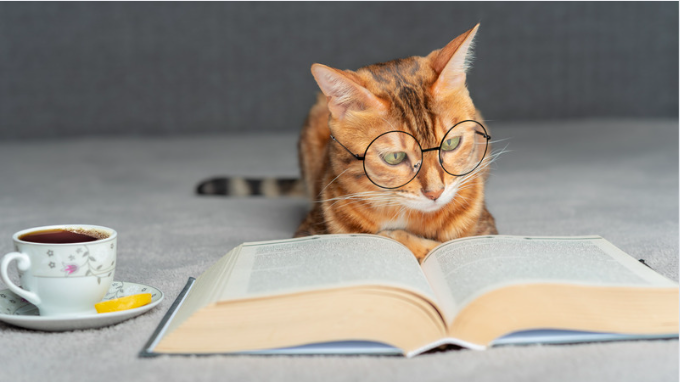
Clever Cats: Breeds That Learn Fast
Cats have always fascinated us with their agility, independence, and sometimes enigmatic behavior. Among the vast array of feline breeds, some stand out for their remarkable intelligence and ability to learn quickly.
In this article, we will delve into the world of these exceptional cat breeds, exploring their unique characteristics, training capabilities, and what makes them such quick learners.
Whether you’re a seasoned cat owner or considering adopting a new feline friend, this comprehensive guide will help you understand the breeds that are not only intelligent but also a joy to train.
Why Intelligence Matters in Cats
Understanding Feline Intelligence
Feline intelligence is a multi-faceted trait that encompasses problem-solving abilities, social learning, and adaptability. Unlike dogs, cats often showcase their intelligence in more subtle ways, such as manipulating objects to get what they want or learning routines and commands.
Benefits of Owning Intelligent Cats
Owning an intelligent cat comes with several benefits. These cats are more interactive and engaging, making them excellent companions. They can learn tricks, follow commands, and even understand basic household rules, which makes living with them more enjoyable and less challenging.
Top Cat Breeds Known for Their Intelligence
Abyssinian
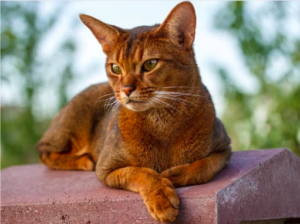
Overview
The Abyssinian is often hailed as one of the smartest cat breeds. Known for their curiosity and playful nature, Abyssinians are quick learners who thrive on mental stimulation.
Training and Activities
Abyssinians are highly trainable and enjoy interactive toys and puzzle feeders. They can learn tricks such as fetching and even walking on a leash. Their love for heights means they appreciate cat trees and climbing structures.
Siamese
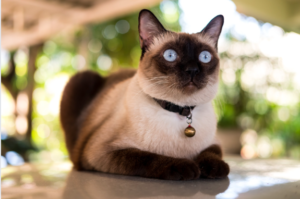
Overview
Siamese cats are not only intelligent but also highly vocal and sociable. They form strong bonds with their owners and are always eager to engage in activities.
Training and Activities
Siamese cats are quick to learn tricks and commands. They enjoy interactive play and can be trained to perform simple tasks like opening doors or retrieving items. Their vocal nature also makes them responsive to verbal cues.
Bengal
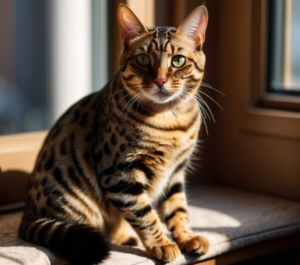
Overview
Bengals are known for their striking appearance and high energy levels. Their intelligence is reflected in their ability to solve problems and learn complex tasks.
Training and Activities
Bengals enjoy activities that challenge their minds, such as agility courses and puzzle toys. They can be trained to walk on a leash and perform tricks. Providing them with interactive playtime helps in channeling their energy positively.
Burmese
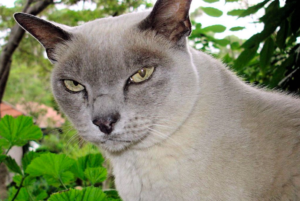
Overview
Burmese cats are affectionate, people-oriented, and intelligent. They enjoy being involved in family activities and can be trained to follow various commands.
Training and Activities
Burmese cats are quick learners and respond well to positive reinforcement. They enjoy learning tricks, playing fetch, and interactive games that stimulate their minds.
Scottish Fold
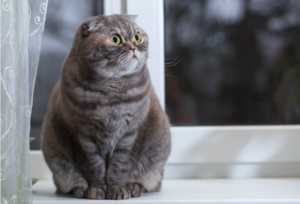
Overview
Scottish Folds are known for their distinctive folded ears and sweet demeanor. Despite their calm appearance, they are intelligent and can learn quickly.
Training and Activities
Scottish Folds enjoy interactive toys and games. They can learn tricks and commands and appreciate routines that keep their minds engaged.
Training Tips for Intelligent Cats
Start Early
Begin training your cat as early as possible. Kittens are more receptive to learning new behaviors and routines.
Use Positive Reinforcement
Reward your cat with treats, praise, or playtime whenever they successfully perform a desired behavior. Positive reinforcement strengthens the association between the action and the reward.
Keep Sessions Short and Fun
Cats have shorter attention spans than dogs, so keep training sessions brief and enjoyable. Incorporate playtime to make learning fun for your cat.
Be Patient and Consistent
Patience and consistency are key when training cats. Repeat commands and routines regularly, and avoid punishing your cat for mistakes. Consistency helps reinforce learning and builds trust.
Challenges of Training Intelligent Cats
Independence and Stubbornness
Intelligent cats can sometimes be independent and stubborn. They might choose to ignore commands if they are not in the mood, so it’s important to understand their behavior and work with it.
Need for Mental Stimulation
Highly intelligent cats require constant mental stimulation. Boredom can lead to behavioral issues, so ensure they have plenty of toys, activities, and interaction to keep their minds engaged.
Managing High Energy Levels
Breeds like Bengals have high energy levels that need to be managed. Providing them with enough physical and mental exercise is crucial to prevent destructive behavior.
Living with Intelligent Cats
Creating an Enriched Environment
An enriched environment is essential for intelligent cats. This includes a variety of toys, climbing structures, scratching posts, and interactive feeders to keep them stimulated.
Social Interaction
Intelligent cats thrive on social interaction. Spend quality time playing, training, and simply bonding with your cat to ensure they feel valued and engaged.
Understanding Their Needs
Each intelligent breed has its own unique needs and preferences. Understanding these and catering to them will help you build a strong and positive relationship with your cat.
Conclusion
Owning an intelligent cat can be an incredibly rewarding experience. These quick learners bring joy, challenge, and companionship to their owners. By understanding their unique characteristics and providing the right environment and training, you can foster a deep and fulfilling relationship with your feline friend.
Whether you choose an Abyssinian, Siamese, Bengal, Burmese, or Scottish Fold, you’re sure to enjoy the remarkable intelligence and personality they bring into your home.
Frequently Asked Questions (FAQs)
What makes a cat breed intelligent?
Intelligent cat breeds often show high levels of problem-solving abilities, adaptability, and social learning. They can quickly learn commands, tricks, and routines.
Can all cats be trained?
While some breeds are more receptive to training than others, all cats can be trained to some extent. Patience, consistency, and positive reinforcement are key to successful training.
What are the best toys for intelligent cats?
Interactive toys, puzzle feeders, and climbing structures are ideal for intelligent cats. These toys provide mental stimulation and keep them engaged.
How do I keep my intelligent cat from getting bored?
Provide a variety of toys, engage in regular playtime, and introduce new activities regularly. Rotating toys and creating an enriched environment also help prevent boredom.
Are intelligent cats more difficult to care for?
Intelligent cats can be more demanding in terms of mental stimulation and interaction. However, with the right approach and environment, they can be delightful companions.
We appreciate you for taking the time to read this article!
Finally, we hope you found this article interesting? And what do you think about ”Clever Cats: Breeds That Learn Fast!?”
Please feel free to share or inform your friends about this article and this site, thanks!
And let us know if you observe something that isn’t quite right.
Cats
The Enchanting Scottish Fold: A Guide to the Adorable Feline with Folded Ears
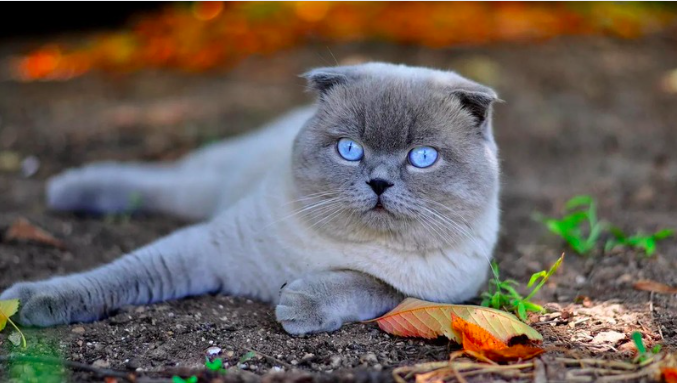
The Enchanting Scottish Fold: A Guide to the Adorable Feline with Folded Ears
Welcome to the world of the Scottish Fold cat, where charm and curiosity meet in an irresistibly adorable package. With their distinctive folded ears and sweet expression, Scottish Folds have captured the hearts of cat lovers around the world. Originally hailing from Scotland, these cats are known for their gentle demeanor, playful nature, and loving personality.
In this comprehensive guide, we will delve into the fascinating world of Scottish Fold cats, exploring their history, physical characteristics, personality traits, and care requirements. Whether you’re a seasoned cat owner or considering adding a feline friend to your family, the Scottish Fold’s unique charm and affectionate nature make them a delightful addition to any home. Join us as we unravel the enchanting tale of the Scottish Fold cat and discover why they are such beloved companions.
Fold
Overview
The Scottish Fold cat is a charming and distinctive breed known for its unique folded ears and sweet expression. Originating from Scotland in the 1960s, these cats have captured the hearts of many with their endearing appearance and affectionate nature. Scottish Folds are known for their gentle and loving temperament, making them wonderful companions for families and individuals alike.
History and Origins
The Scottish Fold breed traces its roots back to a white barn cat named Susie, who was found in Scotland in the early 1960s. Susie had a unique genetic mutation that caused her ears to fold forward, giving her an owl-like appearance. This trait was passed down to her kittens, and thus, the Scottish Fold breed was born. The breed quickly gained popularity for its distinctive look and friendly demeanor, and it was officially recognized by cat registries in the 1970s.
Physical Characteristics
- Folded Ears: The most distinctive feature of the Scottish Fold is its folded ears, which give the cat a sweet and owl-like appearance. Not all Scottish Folds have folded ears; some may have straight ears, known as “straights,” which are also common in the breed.
- Coat and Colors: Scottish Folds can have either a short or long coat, both of which are dense and plush. They come in a variety of colors and patterns, including tabby, tortoiseshell, and solid colors like white, black, and blue.
- Body Structure: Scottish Folds are medium-sized cats with a rounded appearance. They have sturdy bodies, round faces, and large, expressive eyes that give them a sweet and gentle expression.
Personality and Behavior
Scottish Folds are known for their calm and laid-back demeanor. They are affectionate cats that enjoy being around people and are often described as “lap cats” due to their love of cuddling. They are also known for their playful nature and enjoy interactive toys and games. Scottish Folds are generally good with children and other pets, making them a great choice for families.

Health and Care
- Ear Care: Due to their folded ears, Scottish Folds may be prone to ear infections. It’s important to regularly check and clean their ears to prevent issues.
- Grooming: Scottish Folds have dense coats that require regular grooming to prevent matting and tangling. Weekly brushing is usually sufficient to keep their coat in good condition.
- Health Concerns: Scottish Folds are generally healthy, but they may be prone to certain genetic conditions, including a skeletal disorder known as osteochondrodysplasia. Responsible breeding practices can help minimize the risk of these health issues.
Training and Activities
Scottish Folds are intelligent cats that can be trained to perform tricks and commands. They enjoy interactive play and benefit from toys that stimulate their minds and bodies. Providing them with scratching posts and other outlets for their natural behaviors can help keep them happy and healthy.
Compatibility with Families and Other Pets
Scottish Folds are known for their gentle and affectionate nature, making them great companions for families. They are good with children and other pets, including dogs, and can adapt well to different environments. Their loving and sociable nature makes them a popular choice for households looking for a friendly and affectionate pet.
Conclusion
The Scottish Fold cat is a unique and charming breed known for its folded ears and sweet expression. With their gentle demeanor and affectionate nature, Scottish Folds make wonderful companions for families and individuals alike. Whether you’re looking for a lap cat to cuddle with or a playful friend to keep you entertained, the Scottish Fold cat is sure to bring joy and companionship to your home.
FAQs about Scottish Fold Cats
Why do Scottish Folds have folded ears?
Scottish Folds have a genetic mutation that affects the cartilage in their ears, causing them to fold forward. This unique trait gives them their distinctive appearance.
Are Scottish Folds prone to ear problems due to their folded ears?
Yes, Scottish Folds may be more prone to ear infections due to the fold in their ears, which can trap dirt and moisture. Regular cleaning and monitoring of their ears can help prevent issues.
Do Scottish Folds have any health issues associated with their folded ears?
Scottish Folds may be prone to a condition called osteochondrodysplasia, which affects the development of their cartilage and bones. Responsible breeding practices can help reduce the risk of this condition.
Are Scottish Folds good with children and other pets?
Scottish Folds are known for their gentle and friendly nature, making them good companions for families with children and other pets. They enjoy socializing and being part of the family.
Do Scottish Folds require a lot of grooming?
Scottish Folds have dense coats that require regular grooming to prevent matting and tangles. Weekly brushing is recommended to keep their coat in good condition.
We appreciate you for taking the time to read this article!
Finally, we hope you found this article interesting? And what do you think about ”The Enchanting Scottish Fold: A Guide to the Adorable Feline with Folded Ears!?”
Please feel free to share or inform your friends about this article and this site, thanks!
And let us know if you observe something that isn’t quite right.
Cats
The Enchanting Burmese Cat: Affectionate, Playful, and Loyal
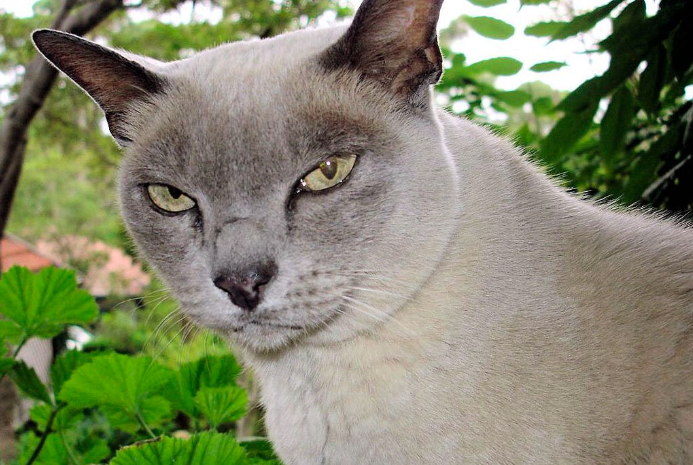
The Enchanting Burmese Cat: Affectionate, Playful, and Loyal
Enter the world of the Burmese cat, where elegance meets affection in a charming feline companion. Originating from the temples of Burma, these cats have captured the hearts of cat lovers worldwide with their striking appearance and loving nature. With their sleek coats, expressive eyes, and playful demeanor, Burmese cats are not just pets; they are cherished members of the family.
In this comprehensive guide, we delve into the captivating world of Burmese cats, exploring their history, physical characteristics, personality traits, and care requirements. Whether you’re a seasoned cat owner or considering adding a feline friend to your family, the Burmese cat’s unique blend of beauty, intelligence, and affection is sure to captivate you. Join us as we unravel the enchanting tale of the Burmese cat and discover why they are such beloved companions.
Burmese
Overview
The Burmese cat is a breed known for its striking appearance and affectionate nature. Originating from Burma (now Myanmar), these cats are renowned for their sleek, muscular bodies, expressive eyes, and silky coats. Burmese cats are often described as “people-oriented,” as they form strong bonds with their human companions and enjoy being part of the family. Their playful and curious nature makes them delightful companions for both children and adults alike.
History and Origins
The history of the Burmese cat can be traced back to ancient Burma, where they were considered sacred and kept by monks in temples. They were later brought to the West in the early 20th century and quickly gained popularity for their striking appearance and affectionate personality. The breed has since become a favorite among cat enthusiasts worldwide, known for its loving and loyal nature.
Physical Characteristics
- Coat and Colors: Burmese cats have short, sleek coats that lie close to the body. They come in a variety of colors, including sable, champagne, blue, and platinum. The coat is soft and silky to the touch, adding to the breed’s overall charm.
- Body Structure: Burmese cats are medium-sized with a muscular build. They have rounded heads, large, expressive eyes, and short, straight noses. Their compact bodies give them a sturdy appearance, and they move with grace and agility.
- Eyes and Ears: Their eyes are one of their most striking features, being large, expressive, and usually a deep, rich color that complements their coat. Their ears are medium-sized, slightly rounded at the tips, and set wide apart on the head.
Personality and Behavior
Burmese cats are known for their affectionate and sociable nature. They are often described as “dog-like” due to their tendency to follow their owners around the house and seek out human companionship. They are also highly intelligent and enjoy interactive play, making them great companions for families with children or other pets.
In addition to their affectionate nature, Burmese cats are also known for their vocalizations. They have a soft, sweet voice that they use to communicate with their owners, often engaging in “conversations” and expressing their needs and desires.
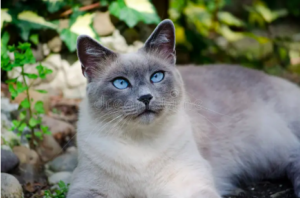
Health and Care
- Grooming: Burmese cats have short coats that require minimal grooming. Weekly brushing is usually sufficient to remove loose hair and keep their coat shiny. They also benefit from regular dental care to prevent oral health issues.
- Diet: A high-quality, balanced diet is essential for maintaining the health and vitality of Burmese cats. They should be fed a diet that is appropriate for their age, size, and activity level to ensure they receive the nutrients they need.
- Health Concerns: Burmese cats are generally healthy, but they can be prone to certain genetic conditions such as hypertrophic cardiomyopathy (HCM) and diabetes. Regular veterinary check-ups and a healthy diet can help manage these risks.
Training and Activities
Burmese cats are intelligent and can be trained to perform various tricks and commands. They enjoy interactive play and thrive on mental stimulation. Providing them with toys, puzzle feeders, and opportunities for play can help keep them entertained and prevent boredom.
Compatibility with Families and Other Pets
Burmese cats are known for their loving and social nature, making them great companions for families. They get along well with children and other pets, including dogs, as long as they are properly introduced. Their affectionate demeanor and playful nature make them a popular choice for households looking for a friendly and engaging pet.
Conclusion
The Burmese cat is a breed beloved for its affectionate nature, striking appearance, and playful personality. Whether you are looking for a loyal companion or a playful friend, the Burmese cat is sure to bring joy and warmth to your home. With their loving nature and sociable demeanor, Burmese cats make wonderful pets for families and individuals alike, enriching their lives with their presence and affection.
FAQs about Burmese Cats
What is the temperament of a Burmese cat like?
Burmese cats are known for their affectionate and social nature. They are often described as “dog-like” due to their loyalty and tendency to follow their owners around the house. They enjoy being involved in family activities and form strong bonds with their human companions.
Are Burmese cats good with children and other pets?
Yes, Burmese cats are generally good with children and other pets. They are playful and enjoy interactive play, making them great companions for families with children. They also get along well with other pets, including dogs, especially if they are introduced properly.
Do Burmese cats require a lot of grooming?
Burmese cats have short, sleek coats that require minimal grooming. Weekly brushing is usually sufficient to remove loose hair and keep their coat shiny. They also benefit from regular dental care to prevent oral health issues.
Are Burmese cats vocal?
Burmese cats are known for their soft, sweet voice, but they are not excessively vocal. They use their voice to communicate with their owners, often engaging in “conversations” and expressing their needs and desires.
What kind of environment is best for a Burmese cat?
Burmese cats thrive in environments where they have plenty of opportunities for play and interaction. They enjoy being part of the family and should have access to toys, scratching posts, and other enrichment activities. They also enjoy having access to outdoor enclosures or safe outdoor spaces where they can explore and indulge their natural instincts.
We appreciate you for taking the time to read this article!
Finally, we hope you found this article interesting? And what do you think about ”The Enchanting Burmese Cat: Affectionate, Playful, and Loyal!?”
Please feel free to share or inform your friends about this article and this site, thanks!
And let us know if you observe something that isn’t quite right.
-

 Pet Care2 years ago
Pet Care2 years agoThe Best Dog Collars For 2022
-

 Dogs2 years ago
Dogs2 years agoBichon Frise: The Happy, Playful, and Cuddly Companion
-

 Trending Pet Stories1 year ago
Trending Pet Stories1 year ago2023 ‘World’s Ugliest Dog’ Winner: Scooter’s Tale of Resilience
-

 Animals3 years ago
Animals3 years agoAre There Animals Having Down Syndrome?
-

 Pets2 years ago
Pets2 years agoThe Fascinating World Of The Red Chameleon
-

 Dogs3 years ago
Dogs3 years agoTop 10 Most Popular Dog Breeds According To AKC.
-

 Dogs2 years ago
Dogs2 years agoDogs 5 Weeks Pregnant: A Comprehensive Guide To Canine Pregnancy
-

 Dogs3 years ago
Dogs3 years ago21 Dog Breeds That Resemble Bears Or Teddy Bears!


